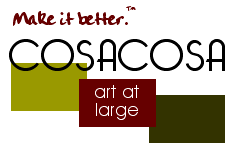



"Our failure to address environmental issues is not a failure of information but a failure of imagination." This comment came from Professor John Robinson of the University of British Columbia at the end of a session I co-organised for the American Association for the Advancement of Science on the role of the arts in the sustainability debate. Corporations struggling with how to move towards a more sustainable future will move further and faster if they focus their efforts on enhancing their imaginations – and those of their customers – rather than on collecting, analysing and disseminating more information.
Art for sustainability
One of the things I do is engage in various forms of art practice. Animal portraits represent some of my work. Working with a team from Michigan State University, we analysed the impact of these portraits on viewers, first in a museum setting and later in a classroom setting. No words, no explicit messages, no attempts to "educate" them in what they should think. Just exposing them to the imagery and letting them think for themselves.
The results were dramatic. Around 90% of the visitors changed their cultural perceptions of animals and spontaneously made statements about the need for more sustainable lifestyles that can help conserve these animals. This happened without a single word being uttered or printed about conservation or sustainability. Viewers were subjected to an emotional experience, allowed to internalise it for themselves and see where that took them. It is an approach that's fundamentally different from the idea of educating by bombarding people with facts and telling them exactly what to think using rational arguments.
Emotional detachment
Our culture is taken up with an all-pervasive pretence at rational, data-driven decision-making. Within many businesses, this culture of the rational is pushed to the extreme. Any form of emotional engagement is frowned upon. When it comes to sustainability, this is largely ineffective. First of all, data is by definition about the past.
Secondly, imagination and commitment are both affective not cognitive processes. They require emotional engagement to work. The rational, data-driven approach tends to keep us stuck in the past and the present, reducing sustainability to mere extrapolation. We reduce the amount of packaging around a product and call it sustainable. We make something out of recycled material and we call it sustainable. We jig our supply chain around and call it sustainable. Yet none of this will be sufficient to deliver a sustainable future. It will simply prolong very slightly the time it takes to hit the wall.
The businesses that will lead the way in sustainability will move away from rationally pursuing sustainability as an extension, with minor tweaks, of our unsustainable culture and lifestyle. They will start reimagining a future that is unknown, currently unimaginable and truly sustainable. How can this be achieved?
Imagination cannot thrive in a culture that privileges the rational and analytical to the exclusion of all else. In leadership circles, the concept of emotional intelligence is already coming to be seen as a key leadership quality. In sustainability we need to go further; to create a capability to allow emotional experiences to unleash the imagination, stimulate creative processes and break us out of incremental extrapolation.
Sustainability won't spring from spreadsheets
Artists, novelists, poets, musicians – they are all in the imagination business yet they are often absent from the business world. I indulge in artistic practices because they take me out of the mind I spend too much time in – the rational, thinking, analytical mind – into a different space where almost everything is possible; where the challenge is to look at the world in a different way, creating new stories that are sufficiently alternative to the reality we already know.
It is exercise for a different part of my brain. Recent neuro-imaging studies have shown that the activation of those neural networks associated with analytical reasoning leads to the actual suppression of brain activity associated with social, emotional and moral cognitive processes. We therefore need to exercise the emotional, imaginative parts of our brains if they are not to atrophy in our world of forced hyper-rationality. If we are to imagine truly alternative futures; worlds, social structures, habits and cultures that seem almost unreal, but which also surprise, challenge and disturb.
Broadening recruitment processes to include people from the arts and the humanities, exposing business executives to artistic practices, creating emotional experiences that are powerful enough to move people to imagine new possibilities. These may be some of the components that we need to explore. The achievement of a truly sustainability lifestyle will not pop out of a spreadsheet. It will not be achieved through technological fixes, efficiency improvements or marginally reduced use of natural resources. It requires a reimagining of the way we live, produce and do business.
The excitement lies in the fact that we still have very little idea of what that might look like. We can let our imaginations let rip. Those businesses that can build the capabilities to imagine more and imagine better will get there first.
Dr Joseph Zammit-Lucia is an independent scholar and commentator. He is president of WOLFoundation.org and can be reached via theintersectionist.com. This essay first appeared in May 24, 2013 edition of the Guardian Professional.